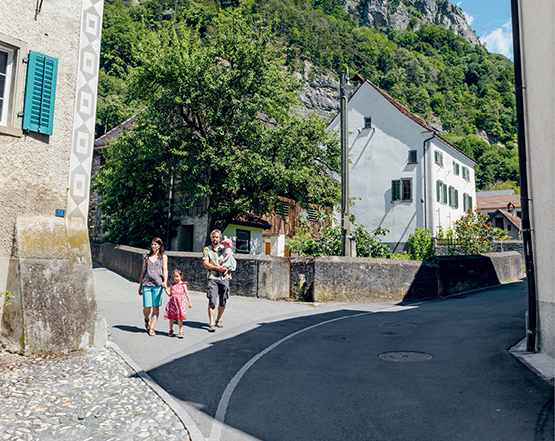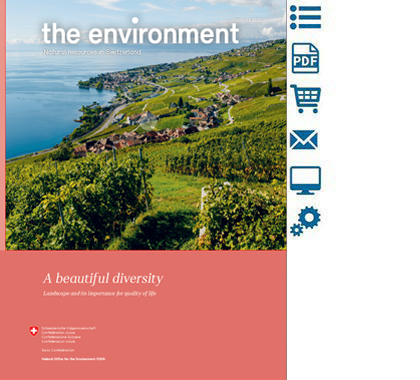Paintings have shaped our notions of the ideal landscape. Yet landscape does much more than “just” provide us with aesthetic pleasure.
Text: Lucienne Rey

© Markus Forte | Ex-Press | BAFU
The yearning for idyllic landscape is at least as old as the pictorial representations of ancient civilisations: murals painted in ancient Egyptian tomb chapels around 1300 BCE show hunting scenes in papyrus thickets and paradisiacal pleasure grounds – testimony to the close relationship between idealised landscape, the society’s religious values, people’s emotions and their aesthetic sensibilities.
Today, our view of landscape is more prosaic, but just as complex. For example, the Landscape Convention of the Council of Europe defines landscape holistically as “an area, as perceived by people, whose character is the result of the action andinteraction of natural and/or human factors”.
As well as providing aesthetic appreciation, the landscape also improves people’s health, creates feelings of place attachment and so helps to forge a sense of identity, and boosts a region’s economic attractiveness. The fact that these four key landscape services are now widely recognised is due in no small part to the debate about ecosystem services that began in the 1990s. This debate was prompted by ideas from environmental economics, namely that natural functions – viewed by traditional economics as being available free of charge – should be given a price, this being the only way to incorporate them into the economic cycle as tradable commodities.
As a result, scientists began to classify the diverse benefits of ecosystems, culminating in the Millennium Ecosystem Assessment launched in 2001. This study into the state of the environment, begun by the United Nations under Secretary-General Kofi Annan, saw the term “ecosystem services”become firmly embedded in the expert lexicon. The associated approach then made its way from the world of research into the Swiss strategies on biodiversity and landscape. “Landscape services are a further development of ecosystem services”, confirms Roger Keller, a geographer at the University of Zurich who researches landscape’s contribution to the development of the economy and society as well as to individual well-being.
However, attempts to express the diverse services rendered by ecosystems as a monetary value are controversial, and landscape services can barely be represented in monetary terms. Thus, while a forest’s function as a filter for clean drinking water can – in theory at least – be given a price tag by comparing it with the costs of the equivalent infrastructure, the four key landscape services are closely interrelated and have no substitutes. Consequently, greater awareness is needed of the value to society and individuals of these four landscape services which are explored in the following portraits.
Identity


“The Hudelmoos near Zihlschlacht is a veryspecial place. I like the springy feel of the ground underfoot and I love the aromatic scents.The sounds are wonderful too. There’s something mysterious about this bog: you could quite easily get lost here in the mist! At the same timeI’m aware of the scars where peat was once dug, which serve as a reminder that we need totreat this habitat with care. That’s why we don’t want hordes of visitors, but welcome thosewho appreciate the beauty of this landscape.”
Heidi Grau-Lanz | Mayor of Zihlschlacht-Sitterdorf (canton of Thurgau)and member of the Thurgau cantonal parliament
Landscapes are shaped by their history and therefore bound up with the stories of the people who live in them – stories that are handed down through the generations: for example, how auntie used to pick beautiful bunches of wild flowers on her way home from school, or how granddad would clean his boots in the village fountain.
Knowing the history of specific features in the landscape makes them even more powerful repositories of identity. The gentle, strip-shaped elevations in the Thurgau/Fürstenland countryside, for instance, many now home to natural meadows or standard fruit trees, are actually ridge and furrow formations created in the Middle Ages. The ploughs used at that time, with their fixed mouldboards, could only deposit the soil on one side and were also difficult to turn. The farmers therefore used to plough in long oval strips around the centre of a field. Over time, soil rich in humus accumulated into ridges, while troughs (furrows) formed around the edges, which acted as drains. A study carried out on behalf of the FOEN concluded that the population should be better informed about these and other such features. It found that there was a lack of awareness about the unique character of these fields, and noted that people were more likely to conserve the landscape if they felt proud of it.
But the feelings of attachment that landscape inspires are not solely linked to its past: residents can identify with an evolving landscape too. “However, the changes mustn’t take place too quickly and the quality of the change is key”, explains landscape researcher Roger Keller. In town and city neighbourhoods, for instance, a redesigned square that encourages people to linger tends to be well received by the locals, as many examples have shown. Moreover, if residents are given a say in the management of “their” landscape, this is likely to foster acceptance of the change – and a feeling of connection to the new.
Aesthetics


“Nobody can fail to be moved by the majesty of Lavaux. Its special atmosphere is attributable first and foremost to the rapidly changing light, as when the sun breaks through the clouds after a storm. It is a landscape shaped by humans, which offers some surprising perspectives: wandering among the vines, it can be quite astonishing to suddenly find yourself almost on top of one of the villages that nestle in the landscape, compactly built to take up as little space as possible.”
Gérald Vallélian | Mayor of St-Saphorin (canton of Vaud), Vice President of LavauxPatrimoine and organic winegrower and cellar master at the Domaine des Faverges vineyard
Because we originated in the savannah, human beings retain a preference for open landscapes with clumps of trees, watercourses and elevated viewpoints – or so goes a traditional theory of landscape perception. In prehistoric times, such areas offered ideal conditions for hunting and fishing, as well as for hiding from predators.
While the needs of modern Homo sapiens may differ from those of their ancestors, certain landscape preferences have remained entrenched. “A vantage point is important, and bodies of water are generally perceived as beautiful”, confirms Roger Keller, a landscape researcher in the University of Zurich’s Department of Geography. Lavaux in the canton of Vaud embodies this ideal, with low-lying Lake Geneva framed by terraced vineyards on its northern shore, and the Alps rising on the opposite side. One also has an overview of the landscape, making it easier to read and navigate the space.
The diversity of its constituent parts is what makes this landscape so attractive. “Compact, homogeneous villages contrast with the structured texture of the sloping vineyards and their walls”, explains Keller. It is not only the material components of the landscape that are varied, but also the lighting: depending on the position of the sun, the lake, which stretches from east to west, shimmers in a variety of shades, from slate grey to opalescent teal to silver. The vegetation also contributes to the play of colours. “Photos are particularly popular in autumn when the vine leaves have turned yellow”, says the expert.
However, a landscape does not retain its charm by always staying the same. “Residents greatlyappreciate the beauty of Lavaux”, Keller has discovered. Holidaymakers also need to be made more aware that this aesthetic pleasure arises from an interplay between conservation and the ongoing development of the landscape.
Economics


“Fläsch focuses on being a place for people to live. It has no industrial zones, and its green spaces have been created in areas designated for building in order to protect the vineyards and orchardsand so preserve the charm of this old wine-growing village. Any new structures must fit in with the character of the surroundings. This is something people value: indeed, many have moved here for that very reason. Even the orthopaedic clinic that opened in 2017 chose Fläsch because of its great quality of life.”
René Pahud | Mayor of Fläsch (canton of Graubünden)
The economic attractiveness of a location is heavily dependent on its landscape qualities. “People look for good accessibility and a high quality of life when deciding where to live”, confirms landscape researcher Roger Keller. Thus, properties in quiet areas and with beautiful views command higher rents: Zürcher Kantonalbank has calculated that great views of a lake or hillside locations with after-noon and evening sun generate an average rental premium of 5%. By contrast, an unattractive view pushes rents down. Overhead power lines are particularly unpopular, due to their visual impact but also fears of the negative effects of electromagnetic radiation. If you are letting a property within150 metres of a power line, you can expect to take a hit of 3% on the rent you can charge.
Highly skilled workers can afford expensive homes in attractive locations with good connections to the nearest urban centre, meaning buoyant tax revenues for the communes concerned.“Switzerland always comes out top in quality-of-life rankings”, says Keller, adding that the landscape plays an important role in this – although determining how important is difficult.
For tourism, the importance of landscape is obvious. Breathtaking panoramas, glittering lakes and other scenic attractions are central to the appeal of many tourist destinations. According to a 2014 study by the Valais Tourism Observatory, tourism in the canton of Valais alone, with resorts such as Zermatt and Saas-Fee, generated gross value added ofCHF 2.4 billion. For the whole of Switzerland, the figure was just under CHF 18 billion in the same period. Even away from the world-famous holiday resorts, it is often the landscape that attracts visitors, albeit in comparatively modest numbers.“Ecotourism will never generate the same revenues as mass tourism”, according to Keller. “But for the regions concerned, providing authentic experiences offers the potential for additional income” (see also p. 26).
Health


“The Gibeleich Nursing Centre in Opfikon, near Zurich, has a large garden. Our residents love it –especially as they are entering the home increasingly late in life so aren’t as mobile as they used to be and are therefore happy that we bring nature to them. Visitors also enjoy strolling in the park area. A lot of the plants from the kitchen garden are used for cooking. For me as well, the garden is somewhereI go to unwind and enjoy the changing seasons!”
Irene Kuhn | Qualified recreational and garden therapist
Attractive landscapes that tempt people outdoors and encourage them to exercise are beneficial for health. People who regularly walk, run or cycle to their destinations tend to stay fitter and live longer than those who are physically inactive. Particularly for diseases in which body weight plays a role, the positive effects of regular exercise are beyond dispute. Activities on a bike and on foot prevent 12,000 cases of cardiovascular disease in Switzerland each year, and a physically active lifestyle also helps to ward off depression and dementia. Various surveys have shown that attractive landscape is a significant factor in people’s choice of a cycle or walking route.
Naturally, there is no “one-size-fits-all” landscape for every activity and every individual. “People’s recreational needs are very varied”, confirms Roger Keller, a landscape researcher at the University of Zurich. “Some like to be active while others want peace and quiet.” This means that a variety of “recreational landscapes” are called for. While cyclists are likely to be happy riding through a residential area with gardens, those seeking silence and relaxation are drawn towards more natural surroundings. This requires a corresponding diversity in the amenities provided in an area: footpaths and cycle paths for the exercise enthusiasts, benches for people who like to sit and enjoy the view and take in the landscape.
Accommodating different demands is not always easy. “Guiding people’s behaviour is an important consideration”, says Keller. For example, having some parts of nature reserves where there are no footpaths and cycle paths will benefit plants and wildlife. Cantonal authorities are still not focusing enough on people’s need to experience the natural world and take part in outdoor activities, according to the expert. Authorities need to think in terms of “recreation planning”, he says, in order to prevent conflicts and optimise offers.
Further information
Last modification 02.09.2020






